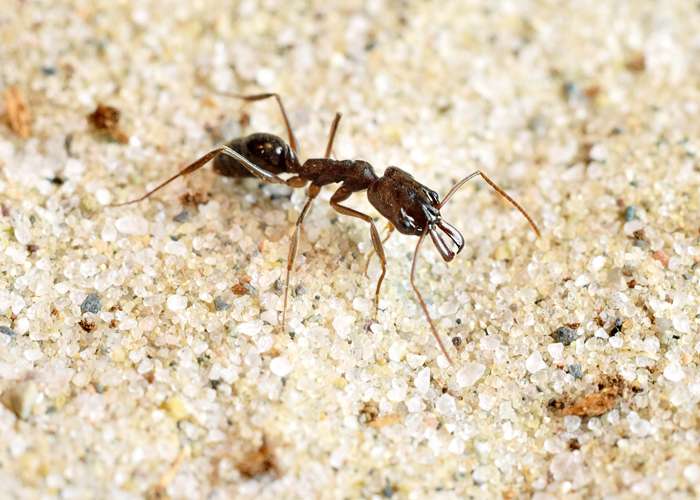Trap-jaw ants jump with their jaws to escape the antlion's den

Some species of trap-jaw ants use their spring-loaded mandibles to hurl themselves out of harm's way when an ant-trapping predator stalks, researchers report in the journal PLOS ONE. This dramatic maneuver doubles the ants' survival when other escape methods fail, the researchers found.
The mandibles of the trap-jaw ant Odontomachus brunneus can whip shut at speeds over 40 meters per second (144 kilometers per hour), instantaneously maiming a prey insect or enemy ant. They also are used for more routine tasks, such as digging nests or tending to eggs and larvae.
Previous studies have reported that trap-jaw ants sometimes jump with their jaws, "but it was unknown whether this behavior was meant to help them get away from a predator, and it wasn't clear that it actually improved their odds of surviving an encounter with a predator," said University of Illinois graduate student Fredrick Larabee, who conducted the study with entomology professor and animal biology department head Andrew Suarez.
The new study verifies that the mandibles do in fact aid the ants' survival by allowing them to eject themselves from a dangerous predicament.
Pit-building antlions have a two-part strategy for capturing prey. First, they dig conical pits in the sand and bury themselves at the bottom of the pit to wait for a victim.
"If an ant falls into the pit, it tries to run away, but the sand crumbles beneath its feet," Larabee said. "This pulls it closer to the center of the pit where the antlion is waiting."The antlion sometimes employs its second strategy: It hurls sand at the ant, causing a tiny avalanche that further destabilizes its target. If the ant tumbles to the bottom of the pit and the antlion grabs it with its mandibles, the ant is doomed.
Larabee dropped trap-jaw ants into antlion pits in the lab to see if, and how often, the ants used the jaw-jumping maneuver to escape from an actual predator.
The ants usually tried to run out of the pit, and sometimes were successful. If that strategy failed, they sometimes jumped with their jaws.
"The ants were able to jump out of the pits about 15 percent of the time in their encounters with antlions," Larabee said. "But when we glued their mandibles shut before dropping them in the pits, they couldn't jump at all. It cut their survival rate in half."
Previous research has showed that O. brunneus sometimes adopts an unusual body posture just before jumping, Suarez said. It lowers its head, making contact with the ground, and occasionally raises a leg before deploying its mandibles to hurl itself into the air.
"Based on our earlier studies, if the ant was striking a prey object, the distance between the ant and the prey was about the length of the trigger hairs that come off the mandibles," Suarez said. "But when they were jumping off a surface, you would often see the ants put their entire face against the surface, and it was more of a pushing behavior than a striking behavior."
The study shows how a trait or capability that evolved for one purpose can be adapted for different uses, Larabee said.
"In this case, a tool that is very good for capturing fast or dangerous prey also is good for another function, which is escape," he said.
More information: "Mandible-powered escape-jumps in trap-jaw ants increase survival rates during predator-prey encounters," PLOS ONE, 2015. dx.plos.org/10.1371/journal.pone.0124871
Journal information: PLoS ONE
Provided by University of Illinois at Urbana-Champaign




















